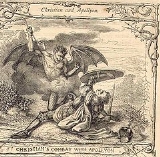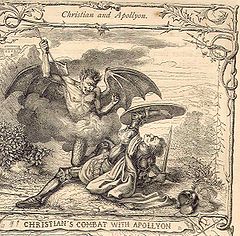
Abaddon
Encyclopedia

Book of Revelation
The Book of Revelation is the final book of the New Testament. The title came into usage from the first word of the book in Koine Greek: apokalupsis, meaning "unveiling" or "revelation"...
of St. John
John the Evangelist
Saint John the Evangelist is the conventional name for the author of the Gospel of John...
, is the king of tormenting locusts and the angel of the bottomless pit. The exact nature of Abaddon is debated, but the Hebrew word is related to the triliteral root אבד (ABD), which in verb form means "to perish."
Biblical mentions
In the Hebrew scriptures, Abaddon comes to mean "place of destruction," or the realm of the dead, and is associated with SheolSheol
Sheol |Hebrew]] Šʾôl) is the "grave", "pit", or "abyss" in Hebrew. She'ol is the earliest conception of the afterlife in the Jewish scriptures. It is a place of darkness to which all dead go, regardless of the moral choices made in life, and where they are "removed from the light of God"...
.
The Christian scriptures contain the first known depiction of Abaddon as an individual entity instead of a place. In St. John's Revelation 9:1-11, Abaddon is described as the king of the bottomless pit and of a plague of locusts that resemble war horses with crowned human faces and having women's hair, lions' teeth, locusts' wings, and the tail of a scorpion.
Other theological works
The text of the Thanksgiving HymnsThanksgiving Hymns
The Thanksgiving Scroll or Hodayot was one of the first seven Dead Sea Scrolls discovered in 1947 by the Bedouin. The scroll gets its name from the recurring use of the phrase “I thank you” in many of the poems, thus ‘Thanksgiving Scroll’ or Hodayot...
—which was found in the Dead Sea Scrolls
Dead Sea scrolls
The Dead Sea Scrolls are a collection of 972 texts from the Hebrew Bible and extra-biblical documents found between 1947 and 1956 on the northwest shore of the Dead Sea, from which they derive their name...
—tells of "the Sheol of Abaddon" and of the "torrents of Belial
Belial
Belial is one of the four crown princes of Hell and a demon in the Bible, Jewish apocrypha and Christian apocrypha...
[that] burst into Abaddon". The Biblical Antiquities
Pseudo-Philo
Pseudo-Philo is the name commonly used for a Jewish pseudepigraphical work in Latin, so called because it was transmitted along with Latin translations of the works of Philo of Alexandria but is very obviously not written by Philo...
attributed to Philo mentions Abaddon as a place (sheol, hell), not as a spirit or demon or angel. In the 3rd century Acts of Thomas
Acts of Thomas
The early 3rd century text called Acts of Thomas is one of the New Testament apocrypha, portraying Christ as the "Heavenly Redeemer", independent of and beyond creation, who can free souls from the darkness of the world. References to the work by Epiphanius of Salamis show that it was in...
, Abaddon is the name of a demon, or the Devil
Devil
The Devil is believed in many religions and cultures to be a powerful, supernatural entity that is the personification of evil and the enemy of God and humankind. The nature of the role varies greatly...
himself. Abaddon has also been identified as the angel of death and destruction, demon of the abyss, and chief of demons of the underworld hierarchy, where he is equated with Samael
Samael
Samael is an important archangel in Talmudic and post-Talmudic lore, a figure who is accuser, seducer and destroyer, and has been regarded as both good and evil...
or Satan
Satan
Satan , "the opposer", is the title of various entities, both human and divine, who challenge the faith of humans in the Hebrew Bible...
. In magic
Magic (paranormal)
Magic is the claimed art of manipulating aspects of reality either by supernatural means or through knowledge of occult laws unknown to science. It is in contrast to science, in that science does not accept anything not subject to either direct or indirect observation, and subject to logical...
, Abaddon is often identified with the Destroying Angel of the Apocalypse
Apocalypse
An Apocalypse is a disclosure of something hidden from the majority of mankind in an era dominated by falsehood and misconception, i.e. the veil to be lifted. The Apocalypse of John is the Book of Revelation, the last book of the New Testament...
.
Abaddon is also one of the compartments of Gehenna
Gehenna
Gehenna , Gehinnom and Yiddish Gehinnam, are terms derived from a place outside ancient Jerusalem known in the Hebrew Bible as the Valley of the Son of Hinnom ; one of the two principal valleys surrounding the Old City.In the Hebrew Bible, the site was initially where apostate Israelites and...
. By extension, it can mean an underworld abode of lost souls, or hell
Hell
In many religious traditions, a hell is a place of suffering and punishment in the afterlife. Religions with a linear divine history often depict hells as endless. Religions with a cyclic history often depict a hell as an intermediary period between incarnations...
. In some legends, it is identified as a realm where the damned lie in fire and snow, one of the places in Hell that Moses
Moses
Moses was, according to the Hebrew Bible and Qur'an, a religious leader, lawgiver and prophet, to whom the authorship of the Torah is traditionally attributed...
visited.
In the lore of the Coptic Church, Abbaton is the name given to the angel of death
Death (personification)
The concept of death as a sentient entity has existed in many societies since the beginning of history. In English, Death is often given the name Grim Reaper and, from the 15th century onwards, came to be shown as a skeletal figure carrying a large scythe and clothed in a black cloak with a hood...
. He is given particularly important roles in two sources, a homily entitled The Enthronment of Abbaton by Timothy of Alexandria
Timothy of Alexandria
Pope Timothy I of Alexandria served as Pope of Alexandria between 378 and 384 He is commemorated in the Calendar of Saints of the Coptic Church on the 26th day of Epip.-References:GeneralSpecific...
, and the Apocalypse of Bartholomew. In the homily by Timothy, Abbaton was first named Muriel, and had been given the task by God
God
God is the English name given to a singular being in theistic and deistic religions who is either the sole deity in monotheism, or a single deity in polytheism....
of collecting the earth which would be used in the creation of Adam
Adam
Adam is a figure in the Book of Genesis. According to the creation myth of Abrahamic religions, he is the first human. In the Genesis creation narratives, he was created by Yahweh-Elohim , and the first woman, Eve was formed from his rib...
. Upon completion of this task, the angel was then named to be guardian. Everybody, including the angels, demons, and corporeal entities, felt fear of him. Abbaton engaged in prayer and ultimately obtained the promise that any men who venerated him during their lifetime stood the chance of being saved. Abbaton is also said to have a prominent role in the Last Judgement, as the one who will take the souls to the Valley of Josaphat
Valley of Josaphat
The Valley of Josaphat is mentioned in only one passage of the Bible, in Joel 3.2 : "I will gather together all nations, and will bring them down into the valley of Josaphat: and I will plead with them there for my people, and for my inheritance Israel, whom they have scattered among the nations"...
. He is described in the Apocalypse of Bartholomew as being present in the Tomb of Jesus
Tomb of Jesus
Several places have been proposed as the tomb of Jesus, the place where Jesus Christ was buried:*Church of the Holy Sepulchre, Jerusalem, accepted by many Christians and scholars as built on ground on which Jesus was crucified and buried...
at the moment of his resurrection
Resurrection of Jesus
The Christian belief in the resurrection of Jesus states that Jesus returned to bodily life on the third day following his death by crucifixion. It is a key element of Christian faith and theology and part of the Nicene Creed: "On the third day he rose again in fulfillment of the Scriptures"...
.
Identifying Abaddon
The symbolism of Revelation 9:11 leaves the exact identification of Abaddon open for interpretation. Some bible scholars believe him to be the antichrist or Satan.The International Bible Students Association (precursor to Jehovah's Witnesses) identified Abaddon as Satan in C.T. Russel's 1917 posthumous work. Jehovah's Witnesses now take the contrasting view, believing that Abaddon is another name of the resurrected and enthroned Jesus Christ.
Some theologians believe Abaddon to be just an angel. Concerning the angel holding the key to the bottomless pit from Revelation 9 and 20, Gustav Davidson
Gustav Davidson
Gustav Davidson was a poet, writer, and publisher.Davidson attended Columbia University in New York City and worked for the Library of Congress.-Works:...
, in A Dictionary of Angels, Including the Fallen Angels, writes:
- In Revelation 20:2 he "laid hold of the dragon, that old serpent, which is the Devil, and Satan, and bound him a thousand years". According to the foregoing, Apollion is a holy (good) angel, servant, and messenger of God; but in occult and, generally, in noncanonical writings, he is evil.

